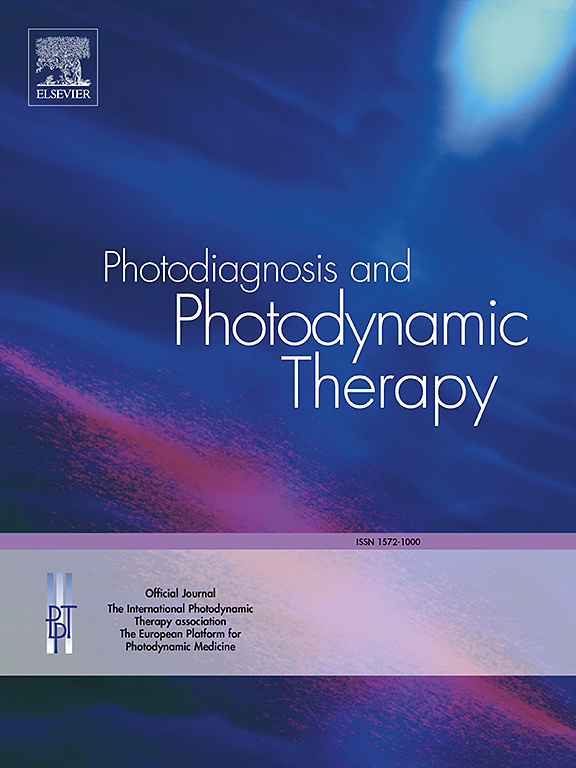手术管理结合光动力治疗在美容术后非结核性分枝杆菌感染中的应用。
IF 3.1
3区 医学
Q2 ONCOLOGY
引用次数: 0
摘要
背景:近年来,由诸如整容手术等侵入性手术引起的非结核分枝杆菌(NTM)感染的患者数量一直在增加。然而,治疗NTM感染面临重大挑战,目前尚无标准化的诊断或治疗指南。方法:本研究纳入10例美容手术后皮肤及软组织NTM感染患者。每位患者均行手术治疗,清创后行PDT。将20%的5-氨基乙酰丙酸(ALA, 2 mL: 10 mg)外用于创面周围(2 cm边缘)进行PDT,然后用能量密度为120 J/cm²的635 nm二极管激光在光遮蔽和激活下孵育3小时。暴露时间根据实时疼痛耐受性动态调整(20-40分钟)。每周进行PDT治疗,总治疗时间根据伤口愈合进展个体化。术后疼痛采用面部表情疼痛量表(FEPS)进行评估,并通过分层方案进行管理:冰敷治疗轻度至中度疼痛(FEPS 2-4),非甾体抗炎药/阿片类药物治疗重度疼痛(FEPS bbbb4)。根据药敏试验结果选择抗生素。结果:10例患者均获得临床治愈,治疗时间明显缩短。所有患者随访6个多月,无感染复发。pdt后疼痛在所有患者中普遍存在,FEPS评分从2到7不等,并通过最终治疗得到有效控制。短暂的不良事件包括红斑(n=10)和瘙痒(n=2),在48小时内自行消退。无慢性并发症。结论:手术干预联合PDT,配合适当的抗生素治疗,是治疗美容术后皮肤软组织NTM感染安全有效的方法。方法:采用20% ALA (10 mg/次)外用于创面周围(2 cm边缘),封闭3小时,635 nm激光照射(120 J/cm²;xd - 635 ab)。暴露时间根据实时疼痛耐受性动态调整(20-40分钟)。每周治疗一次,直到伤口愈合。疼痛严重程度(FEPS)通过分级方案进行管理:冰/非甾体抗炎药评分为2-4分,阿片类药物评分为bb0 -4分。PDT采用20%的5-ALA,由635 nm激光激活,光剂量为120 J/cm²。本文章由计算机程序翻译,如有差异,请以英文原文为准。
Application of surgical management combined with photodynamic therapy in the treatment of nontuberculous mycobacterial infections after cosmetic surgery
Background
In recent years, the number of patients with nontuberculous mycobacteria (NTM) infections caused by invasive procedures such as cosmetic surgery has been increasing. However, treating NTM infections presents significant challenges, with no standardized diagnostic or treatment guidelines currently available.
Methods
This study included 10 patients diagnosed with skin and soft tissue NTM infections following cosmetic surgery. Each patient underwent surgical treatment, followed by Photodynamic therapy (PDT) after debridement. PDT was performed using topical 20 % 5-aminolevulinic acid (ALA, 2 mL: 10 mg) applied to the wound periphery (2 cm margin), followed by a 3-hour incubation under light occlusion and activation with a 635 nm diode laser at an energy density of 120 J/cm². Exposure durations were dynamically adjusted (20–40 min) based on real-time pain tolerance. Weekly PDT sessions were administered, with total treatment duration individualized according to wound healing progression. Post-procedural pain was assessed using the Facial Expression Pain Scale (FEPS) and managed through a tiered protocol: ice compression for mild-to-moderate pain (FEPS 2–4) and NSAIDs/opioids for severe pain (FEPS >4). Antibiotics were selected based on the results of drug susceptibility testing.
Results
All ten patients achieved clinical cure, with a notable reduction in the duration of therapy. All patients were followed for over six months without recurrence of infection. Post-PDT pain was universally in all patients, with FEPS scores ranging from 2 to 7, and managed effectively by the final treatment. Transient adverse events included erythema (n = 10) and pruritus (n = 2), resolving spontaneously within 48 h. No chronic complications were observed.
Conclusion
The combination of surgical intervention and PDT, along with appropriate antibiotic therapy, may be a safe and effective approach for treating skin and soft tissue NTM infections after cosmetic surgery.
求助全文
通过发布文献求助,成功后即可免费获取论文全文。
去求助
来源期刊

Photodiagnosis and Photodynamic Therapy
ONCOLOGY-
CiteScore
5.80
自引率
24.20%
发文量
509
审稿时长
50 days
期刊介绍:
Photodiagnosis and Photodynamic Therapy is an international journal for the dissemination of scientific knowledge and clinical developments of Photodiagnosis and Photodynamic Therapy in all medical specialties. The journal publishes original articles, review articles, case presentations, "how-to-do-it" articles, Letters to the Editor, short communications and relevant images with short descriptions. All submitted material is subject to a strict peer-review process.
 求助内容:
求助内容: 应助结果提醒方式:
应助结果提醒方式:


